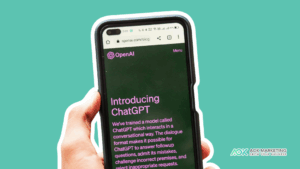In order to be successful, your website must do more than exist.
It needs to be optimized for conversion, which means that every element on the page—from the headline to the call-to-action (CTA)—is designed to encourage website visitors to take a specific step.
Writing for conversion can be challenging, but it’s well worth the effort.
If you’re unsure where to start, don’t worry.
After all, what’s the point of driving traffic to your website if it isn’t going to convert?
We’re here to help. This blog post will share tips on writing copy that converts.

The Importance of Copywriting
Whether you’re creating content for a website, a blog post, or a sales page, the written word is essential. That’s where copywriting comes in.
Copywriting is the process of crafting persuasive and interesting text that will engage your audience and persuade them to take action.
While it may seem daunting, anyone can learn the basics of copywriting with a little practice. And when it comes to creating compelling content, there’s no substitute for a well-written piece. So if you’re ready to take your writing to the next level, it’s time to start thinking about copywriting.
Here are a few reasons why copywriting is so important.
Copywriting persuades people to take action.
Convincing someone to buy a product or sign up for a service takes more than just providing information. You need to use the power of persuasion to convince them that your offering is the best solution to their problem.
Next, copywriting is the foundation of all marketing.
All marketing materials—including website content, blog posts, email campaigns, and social media posts—are based on copy. Understanding copywriting basics will help you create more effective marketing materials, even if you’re not a professional writer.
Copywriting attracts attention.
In a world where we’re bombarded with marketing messages, capturing attention and maintaining it long enough to get your matter or topic across is more important than ever. Copywriting is the key to creating compelling content that will stand out from the noise.
Copywriting sells products and services.
At the end of the day, businesses need to make money. And copywriting is one of the most effective ways to sell products and services. Copywriting can greatly impact your bottom line from effective website copy to compelling sales pages.
Now that we’ve discussed the importance of copywriting, let’s look at some tips for writing copy that converts.
Power Words Usage
Power words are words that evoke an emotional response in readers.
These words are often used in headlines and calls to action because they are so effective at grabbing attention and driving conversions. Some examples of power words include “free,” “save,” and “new.”
When used correctly, power words can be extremely effective at driving conversions.
However, it’s important not to overuse them. Otherwise, your copy will come across as cheap or spammy. Instead, use power words sparingly and pair them with other elements, such as strong visuals, to create an impactful and conversion-friendly message.
Create a Sense of Urgency
One of the most satisfactory ways to encourage website visitors to take action is by creating a sense of urgency.
You can do this by using phrases such as “limited time only” or “act now.”
This type of language taps into our natural fear of missing out and encourages us to take action before it’s too late.
Of course, it’s crucial not to overdo it with a sense of urgency; otherwise, people will start to feel like they’re being pressured into taking action, and they’ll be less likely to convert.
A sound rule of thumb is to use urgency sparingly and only when it genuinely applies.
For example, if you’re running a sale that ends at midnight tonight, use language that communicates that sense of urgency.
Make It Easy for People to Convert
The more effortless you make it for people to convert, the more likely they will do so.
That’s why it’s important to include a CTA—or call-to-action—on every page of your website.
A CTA is a picture or text that encourages visitors to take precise action, such as adding something in their carts, signing up to your newsletter or even buying from you.
Your CTAs should be clear and concise; otherwise, people won’t know what you want them to do.
For best results, place your CTAs above the fold—in a position on the page where visitors can see them without scrolling down—and make them stand out from the rest of your content with colors or whitespace.
What to Consider Before Writing Copy
Before you start writing copy, there are a few things you need to take into account and these include your audience, your brand voice, and your goals.
Your audience is the group of people you’re targeting with your marketing materials. This will help you determine the language and tone you should use.
To effectively connect with your audience, you need to know who they are and what they want.
Also, your audience is much more than just a target demographic. Each person in your audience is an individual with their own specific needs and wants. Get to know your audience personally, and you’ll be able to connect with them on a deeper level and reach them more effectively.
Next, your brand voice is how your business speaks to its customers.
It’s the personality of your business, and it should be unique to you. Your brand voice should also be uniform across your marketing channels—from your website to social media posts.
Your brand voice should reflect your company’s values and how you want people to perceive your business. For example, your brand voice should be warm and conversational if you want to come across as friendly and approachable.
Finally, you need to know what you want to achieve with your copy.
What are your goals? Do you want to increase sales, drive traffic to your website, or build brand awareness?
Once you know your goals, you can start crafting copy to help you achieve them accordingly.
Traffic Sources
There are various ways to generate traffic to your website. These include organic search, paid search, social media, email marketing, and referrals.
Organic search traffic comes from people who find your website through a search engine, such as Google. This type of traffic is free but can take a while to build up.
On the other hand, paid search traffic comes from people who click on ads that appear in search engine results. This type of traffic is not free, but it can be an effective way to get people to your website quickly.
Meanwhile, social media traffic comes from people who find your website through social media platforms like Facebook or Twitter.
Email marketing traffic comes from people who find your website through an email that you’ve sent them.
Lastly, referral traffic comes from people who find your website through a link on another website.
Generating traffic to your website is essential for growing your business. But it’s not enough to just generate traffic—you need to generate the right traffic.
The suitable traffic comprises people interested in what you offer and likely to buy from you. You can also use targeted keywords to attract the right people to your website.
What are Keywords?
Keywords are the terms and words individuals use when they search for something on the internet. Utilizing appropriate keywords in your content makes it easier for people to find your website when they’re scouring for something related to your business.
For example, if you sell shoes, you might use keywords like “shoes,” “sneakers,” or “footwear.”
You can use a keyword research tool like Google AdWords Keyword Planner to find the right keywords for your business.
Once you’ve generated traffic to your website, it’s important to track where it’s coming from. This will help you see which traffic sources are most effective and where you should focus your efforts.
You can track your website traffic using Google Analytics. This free tool gives you detailed information about your website traffic, including where it’s coming from and what individuals are doing on your site.
Google Analytics can be a bit overwhelming, but luckily, there are plenty of helpful tutorials online that can show you how to set it up and use it to your advantage.
Now that you know how to generate traffic to your website, let’s look at ways to convert that traffic into customers.
Your USP (Unique Selling Proposition)
Every enterprise has one or two things that make it unique, and this is called your USP (unique selling proposition).
Your USP sets you apart from your competitors and makes you the only choice for your target market.
For example, let’s say you sell organic baby food.
Your USP might be that you’re the only organic baby food company that uses locally sourced ingredients. Or you’re the only company offering organic baby food delivery.
Whatever it is, emphasize your USP on your website and in all your marketing materials. Your USP will make people choose you over your competitors, so clarifying your USP is important.
Once you’ve identified your USP, you must ensure that your website and marketing reflect it. Your website should be designed to clarify what your USP is and why people should choose you over your competitors.
Your marketing materials should highlight your USP and explain why people should choose your products or services. Remember that your USP can change over time, so it’s important to review it regularly and ensure that it’s still accurate.
Converting Traffic Into Customers
There are several steps you can take to convert traffic into customers.
The first is to ensure your website is designed to make it easy for people to buy from you.
Your website should be straightforward and uncomplicated to navigate. And your site should also be transparent about what you’re selling and how much it costs.
In addition, you should also include persuasive copy that tells people why they need your product or service.
And finally, your website should have a strong call to action that tells people what you like them to accomplish, such as “buy now” or “sign up for our newsletter.”
If you have an online store, you should also ensure the checkout process is quick and easy. People are more likely to abandon their purchase if the long and complicated checkout process.
Next, you can also use retargeting ads to convert traffic into customers.
Retargeting ads track people around the internet after they’ve visited your website. We know, creepy right? These ads remind people about your product and persuade them to return to your site and buy it.
You can utilize Google AdWords to create retargeting ads or work with a retargeting ad platform like AdRoll.
Lastly, you can use email marketing to convert traffic into customers.
Email marketing is a way of staying in touch with your customers and prospects through email. You can use email to send people information about your product, special offers, or other updates. You can also use email to build relationships with your customers and create a sense of loyalty.
If you’re unsure how to get started with email marketing, you can sign up for a service like MailChimp or Constant Contact. These services provide templates, tools, and resources that make creating and sending emails easy.
What to Test in Writing for Conversion
After implementing the steps above, you should see an uptick in conversions. But there’s always room for improvement, so it’s important to test different elements of your website and copy.
You should test a few key things in your writing to see what converts traffic into customers.
Headlines.
Your headlines are the foremost thing people see, so it’s important to make sure they’re attention-grabbing and persuasive.
You can experiment with different headlines to see which ones get more clicks. You can also use a tool like BuzzSumo to see the most shared headlines.
Calls to action.
As we mentioned, your call to action should tell people what you want them to do, such as “buy now” or “sign up for our newsletter.”
You can test different calls to action to see which ones get more people to take the desired action.
Email subject lines.
Your email subject lines must be interesting and persuasive enough to get people to open your emails.
You can test different subject lines to see which ones get more people to open and click through to your email.
Clarity
Clarity should also be considered when testing headlines, calls to action, and email subject lines. Your headlines, calls to action, and email subject lines should be clear and easy to understand.
If people can’t understand what you’re trying to say, they will not take the desired action.
First Person vs. 3rd Person
It’s also important to consider the point of view you’re using in your headlines, calls to action, and email subject lines.
In general, using the first-person point of view is more persuasive than using the third person. The first-person point of view uses pronouns like “I” and “we” and speaks directly to the reader.
The third-person point of view uses pronouns like “he,” “she,” and “it” and speaks about the reader.
For example, a headline written in the first person point of view might be “I Lost 20 Pounds in 2 Weeks!” A headline written in the third person point of view might be “She Lost 20 Pounds in 2 Weeks!”
The first-person point of view is more persuasive because it speaks directly to the reader.
You can see what works best for converting traffic into customers by testing different elements of your writing. Keep testing and tweaking until you find a formula that works for you.
Disclaimers
When you’re writing for conversion, it’s important to use disclaimers. A disclaimer is a sentence remark that tells the reader that your results are not typical.
For example, if you’re writing an article about how you lost 20 pounds in 2 weeks, you would want to add a disclaimer that says, “Results are not typical.”
This is important because you don’t want to make false promises to your readers.
You need to add a disclaimer if you’re making claims that are not typical. This will protect you from legal trouble and help you build trust with your readers.
Text Spacing
The spacing of your text can also affect conversion.
When people are reading online, they tend to skim rather than read word-for-word.
You can make your content easier to read and more likely to be converted by adding white space around your paragraphs and using shorter sentences.
You should also break up your content into smaller chunks with headlines and subheadings. This will make it easier for people to scan your content and find the information they’re looking for.
You can increase conversion by making your content easier to read.
Lists
People love lists.
When you’re writing for conversion, it’s a good idea to use lists whenever possible.
Lists are easy to read, making it easy for people to find the information they’re looking for.
For example, if you’re writing an article about the best ways to lose weight, you could make a list of the top 10 tips.
People are more likely to read and remember your content if it’s in the form of a list.
You can increase conversion by using lists in your writing.
Images
Images are also important for conversion.
People are more likely to read and remember your content if it includes images.
Images can also help to break up your text, making it easier to read.
You should always use relevant images for your topic and add value to your content.
You can increase conversion by using images in your writing.
Answer Objections
When writing for conversion, you need to anticipate objections and address them in your content.
For example, if you’re writing an article about the benefits of a new diet, you need to anticipate objections like “I don’t have time to cook” or “I don’t like healthy food.”
You can address these objections by including tips for making quick and easy meals or a list of delicious healthy recipes.
If you anticipate and address objections to your content, you’ll be more likely to convert readers into customers.
Free stuff!
People love free stuff.
You can increase conversion by offering a free trial or sample if you sell a product or service.
You can also offer free ebooks, checklists, and other resources that will help your readers.
People are more likely to buy from you if they know they’re getting something for free.
Dynamic Keywords on your Landing Page
If you’re using a landing page to sell a product or service, it’s important to use dynamic keywords.
Dynamic keywords are keywords that change based on the user’s search query.
For example, if someone searches for “weight loss tips,” you want to use the keyword “weight loss tips” on your landing page.
Dynamic keywords help to personalize your content and make it more relevant to the reader.
You can increase conversion by using dynamic keywords on your landing page.
Final Thoughts
These are just a few tips on writing copy that converts.
However, remember that there is no one-size-fits-all approach to writing for conversion; what works for one business might not work for another. The best way to find out what works for you is through experimentation and testing different techniques until you find something that works well for your business and your audience.
Additionally, when it comes to writing for conversion, the most important thing is to focus on your audience and what they want. If you can give them what they want, you’ll be more likely to convert them into customers.
If you have any questions or comments, please feel free to leave them below. We would love to hear from you!
About The Author
Rehj
With over 15 years of experience in copywriting, Rehj has established a reputation as a highly skilled and talented wordsmith. Rehj has honed their craft throughout her career, consistently producing top-quality content for various audiences and industries.
Her ability to understand their target audience, craft compelling narratives, and write in a style that resonates with their audience has made them a sought-after copywriter in their field. Rehj’s passion for writing and commitment to producing top-notch content has driven their success and established them as a trusted voice in copywriting.





